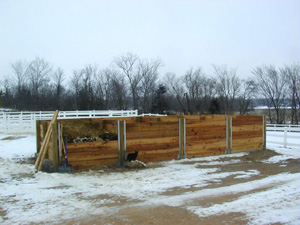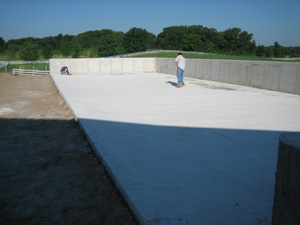
Managing manure is key to responsible horse ownership regardless of how many horses you own or manage. Farmers consider manure a valuable nutrient resource for soils.
The average 1,000-pound horse eats about 2 percent of its body weight and drinks 10 to 12 gallons of water daily. This will vary with individual metabolism, activity level, and the weather.
On average, that same 1,000-pound horse will pass 55 pounds of manure (feces and urine combined) each day. This adds up to more than 10 tons each year.
Of that 55 pounds of fresh manure excreted daily, there is roughly 0.2 pounds of nitrogen, 0.05 pounds of phosphorus, and 0.12 pounds of potassium (K). These are just averages, though, and depend on your horse's activity levels and feed. Plus, bedding may influence the nutrients in the manure, as well. It is always a good idea to regularly test your manure so that you know what you are working with.

Stockpiling is making a pile of solid manure and leaving it alone. You may or may not add manure to it. Stockpiling can occur on a temporary or permanent site.
You must remove and use temporary stockpiles within a year of storage. This allows the site to recover and for plants to grow back. You can then start another temporary stockpile at a new site. Moving to new sites prevents excess nutrient build-up in the soil. Choose these sites carefully and consider soil type and groundwater separation.

Permanent stockpiling occurs at the same site each year. These sites consist of an impervious surface such as concrete or asphalt.
Make sure to research existing state guidelines for stockpiling manure before establishing or constructing a manure stockpile. The Minnesota Pollution Control Agency (MPCA) outlines these guidelines in Manure Stockpiling Technical Guidelines.
You must actively manage composting from the time you make the pile.

Due to rental and hauling costs, a dumpster may be more practical for barns that spend a lot of time handling manure. Dumpsters are convenient. You can fill the dumpster with manure and switch dumpsters when it is full. Make sure to weigh the convenience cost against the added dumpster cost.
The type of storage facility most appropriate for your barn will vary by:
Barns with less than 15 horses or that often pasture horses will produce a limited amount of manure. In this case, small, temporary bins or wire continuous bins work well. They are relatively compact and inexpensive to install.
Barns with 15 or more horses produce a great amount of manure. Facility design and construction can be costly, but it can save long-term labor and costs. The principles are similar to smaller facilities but the following are key:
Before construction, contact your local county feedlot officer or MPCA feedlot contact to determine other regulatory requirements. The Soil and Water Conservation District (SWCD) or USDA Natural Resources Conservation Service (NRCS) in your county may assist you with designing and building a storage site or facility that meets your needs. Individual SWCD and NRCS offices have specific criteria required for offering technical assistance.
Composting is managed, accelerated breakdown of organic materials by microbes (bacteria, fungus and molds). The goal of the composting process is to provide these microbes with a good environment that encourages quick and efficient manure breakdown. Effective composting does the following:
A manure pile will eventually break down if left alone but will lose nutrients and become infested with unwanted organisms.
The larger the pile, the easier it is to keep the composting process going.
The storage area doesn’t need walls, but walls will help contain the compost and allow airflow. You can use pallets, chicken wire, straw bales and slatted boards for walls.
You can use piles that aren’t turned if you allow airflow through perforated pipes. Airflow can be passive or forced with blowers. You can apply design guidelines for larger manure storage sites for smaller compost bins as well.
Horse manure compost piles need these key elements:
When composting dead animals, always follow best practices for composting mortalities. Never try composting a horse carcass within your manure pile. For more information, visit the Constructing and managing a horse carcass compost pile page.
* Many fungi and spores are not killed in the composting process. Adding them can spread the disease further.
** Experienced composters can compost these, but correct temperatures MUST be met.
Mixing the compost gives the microbes access to the nutrients they need. Add water during mixing until it reaches the moisture level of a wrung-out sponge. It’s hard to add water throughout the pile outside the mixing process.
Check the temperatures and remix the pile as needed. A correct mixture pile heats between 140 and 160 F and holds that temperature for 3 weeks. Use a temperature probe, which you can purchase from a farm store, to check the temperature. Turn the pile if temperatures exceed 160 F or when temperatures begin to decline.
A lower temperature usually means missing ingredients. Often these piles need more nitrogen or water. Remix after adding the needed ingredients.
The composting process is nearly complete when it doesn’t heat after mixing and you can’t recognize the original ingredients.
You may not be able to attain desired temperatures during winter in Minnesota. Stockpile manure over winter and resume composting in the spring.
Compost curing occurs in the last 1 to 2 months during which time the temperature will reduce to ambient levels. The finished product will look like something between potting soil and large, dark brown wood chips depending on the material size. Finer material composts more quickly.
You can use finished compost for:
Never spread more than 1/2 inch of compost at a time when spreading compost on a yard, pasture or hay field.
Whether composted or not, you will eventually need to move and use the manure. You can use manure onsite by spreading it as a fertilizer on an open area, pasture or field.
You can also haul manure offsite for fertilizing or composting. Use caution when spreading manure on pastures grazed by horses. Don’t spread manure on pastures if there are more than 1 horse per 2 acres. Spreading manure in heavily stocked pastures could result in increased parasite exposure.
Spreading manure for fertilizer is a great way to use it. But use caution to prevent excess nutrient buildup. To determine how much manure to spread on a field:
Contact your local County Extension Office for help in computing the manure nutrient content and soil and crop needs. More detailed information can be attained through the MPCA fact sheet Land Application of Manure: Minimum State Requirements.
All horse facilities should have a manure management plan, which includes: